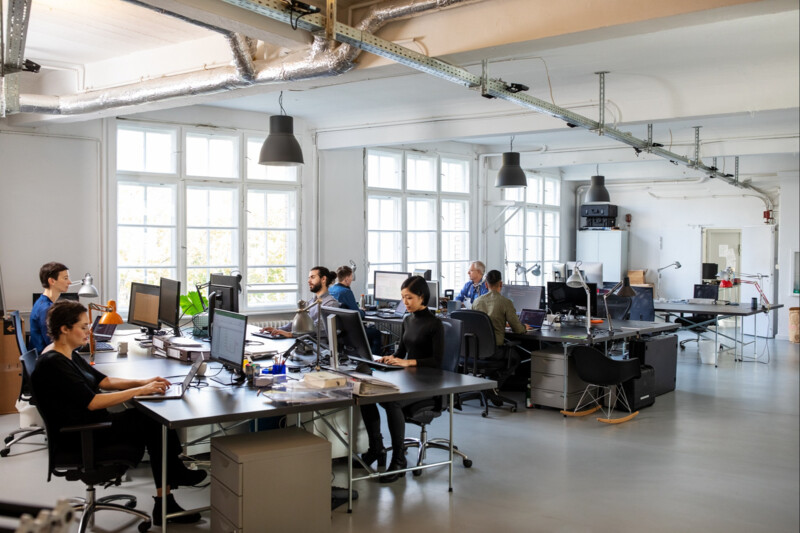Certains secteurs peinent à recruter des salariés, le turn-over et le taux d'absentéisme sont parfois élevés. Il s'agit la plupart du temps d'emplois manuels, dans le bâtiment ou la restauration entre autres, mais dans les bureaux aussi il est essentiel de veiller à améliorer les conditions de travail. En quoi changer l'aménagement des bureaux va-t-il contribuer à augmenter la productivité au travail ? Zoom sur les nouvelles tendances du monde professionnel : flex office, phone room, huddle room...
La qualité de vie au travail
Un ensemble de facteurs influence la qualité de vie sur le lieu de travail : sécurité et hygiène des locaux, confort, calme, ambiance agréable, environnement esthétique, espaces dédiés à la détente, matériel ergonomique, éclairage adéquat...
Assurer le bien-être de ses salariés devient une obligation pour l'employeur. On s'aperçoit que les initiatives menées dans ce sens apportent bien des avantages pour l'entreprise comme pour les travailleurs :
- Augmentation de la motivation,
- Diminution du stress,
- Diminution des arrêts maladie et des coûts qu'ils entraînent,
- Fidélisation du personnel,
- Augmentation de l'attractivité de l'entreprise,
- Meilleure image de marque,
- Amélioration de la productivité et de la compétitivité.
Il est prouvé que lorsqu'un salarié se sent bien dans son environnement de travail, il est plus performant et plus investi dans les projets de l'entreprise.
À quoi ressemblent les nouveaux espaces de travail ?
Terminés les bureaux individuels fermés. Cela fait quelques années déjà que les entreprises ont adopté un mode de travail collaboratif en créant des espaces favorisant la convivialité et les échanges entre collaborateurs (open spaces, coworking, flex office...). Certaines ont fait appel à des architectes d'intérieur spécialisés en aménagement professionnel pour optimiser leurs locaux.
Un aménagement de bureau adéquat comprend notamment :
- Une température idéale et constante contrôlée par un thermostat ;
- Une climatisation en cas de forte chaleur ;
- Un éclairage non agressif, naturel si possible, et à variateur ;
- Une aire de repos intérieure et extérieure ;
- Un espace tisanerie ;
- Des casiers fermés pour ranger les affaires personnelles ;
- Des plantes vertes ;
- Des couleurs murales naturelles et apaisantes dans les tons verts, beiges et bruns ;
- Des matériaux comme le bois, le cuir ou la pierre ;
- Du mobilier professionnel ergonomique : confortable, réglable, étudié pour éviter les douleurs musculaires et la fatigue visuelle ;
- Des cloisons à isolation phonique contre les nuisances sonores (certains postes de travail nécessitent de la concentration et doivent être situés au calme, sans interférences).
Le concept consistant à introduire des éléments de la nature au sein des bureaux est appelé « design biophilique ». Il est destiné à réduire le stress et l'anxiété au travail. C'est une des dernières tendances en matière d'agencement.
Certaines entreprises ont opté pour le flex office qui consiste à ne pas assigner un poste fixe à un salarié en particulier. Chacun peut aller s'asseoir où bon lui semble et commencer à travailler. Il est impératif dans ce cas que les bureaux soient modulables pour s'adapter à tous les besoins et à toutes les morphologies.
Les tendances de l'après-Covid
Avec la pandémie et la distanciation sociale imposée, de nombreux salariés se sont vus obligés de télétravailler. Le télétravail jusqu'alors peu répandu s'est rapidement généralisé. Plus de deux ans après, les habitudes de travail à distance sont restées ancrées dans beaucoup d'entreprises et bouleversent les espaces de travail traditionnels.
Mais, bien que certaines entreprises ont renoncé à avoir des locaux, la plupart d'entre elles considèrent malgré tout que les bureaux restent indispensables pour garder un lien social, même si les outils de communication sont de plus en plus développés.
L'aménagement du lieu de travail doit encore se réinventer. Pour anticiper une nouvelle pandémie, la sécurité sanitaire est à mettre en place : mobilier facilement transportable, modulable, hygiène renforcée....
Le travail hybride, c'est-à-dire 50 % en télétravail et 50 % en présentiel, semble devenir la norme, nécessitant des équipements adaptés aux nouveaux besoins. Des phone rooms peuvent par exemple être prévues pour les réunions téléphoniques, des huddle rooms pour les visioconférences, et des espaces partagés pouvant convenir à tous les salariés, peu importe leur fonction. Le coworking existait déjà, mais connaît un véritable essor actuellement.
Les travailleurs souhaitent maintenant un lieu de travail plus sain, des matériaux durables et respectueux de l'environnement, de la verdure. Habitués à travailler chez eux, ils aspirent à retrouver un espace cocooning au travail, de la flexibilité et une certaine liberté.
Le bonheur des salariés faisant en partie la réussite d'une entreprise, il est fondamental pour les dirigeants de le prendre en compte.
